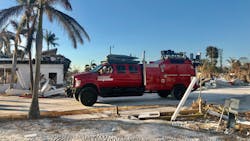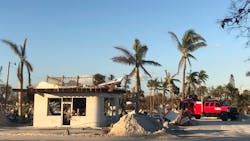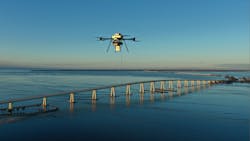When Ian made landfall in southwest Florida on Sept. 28 as a strong Category 4 hurricane, first responders were left to deal with the aftermath and launch large-scale search and rescue missions with no connectivity after the stormed disabled cell towers and knocked out power to a majority of the coast where the impact was felt the hardest.
Verizon Frontline was ready to support first responders in places like Fort Myers Beach, which was hit by catastrophic storm surges that drastically changed the landscape of the community and left those who decided to stay trapped inside their residences. Cory Davis, Assistant Vice President for Verizon Frontline recently spoke to Officer.com about how the company is helping first responders on the ground and how new technology is helping aid the response to destructive national disaster events such as Ian.
“Our main priority is making sure the first responders have the mission critical solutions that they need,” he says. “These guys have been working 24/7, around the clock and they’re still in active search and rescue missions.”Preparing for the storm
Davis and his team arrived in Florida right after the hurricane made landfall and got to work, supporting over 70 agencies within the state. He said that the planning doesn’t start when disaster hits, but instead is a year-round process. This includes internal simulations as well as joint training exercises with state, local and federal agencies.
“For this storm specifically, my team, we’re also kind of amateur meteorologists. As soon as we saw the wave down north of Venezuela was going to start to turn into a tropical storm, we started planning. From there, it kind of turns into a chess match,” he says. “Where’s it going to go? It was very uncertain. We thought it was going to kind of tow up a little bit north. So, literally, 24/7 we’re monitoring it, watching it, then, as it starts to get closer and all of those models start to come together—those spaghetti models—and it becomes a little bit more accurate, that’s when we start to get really laser focused.”
Every hurricane has its own unique characteristics. In the case of Hurricane Katrina, intense flooding overwhelmed New Orleans. With Hurricane Ian, the population around Fort Myers Beach caused challenges with evacuating residents and the amount of damage that has been done. “It’s a beach community and it’s all local businesses,” says Davis. “People’s homes and businesses have been there since the 1920s, the 1940s. They’ve been completely leveled.”
Current estimates have Ian set to become one of the costliest storms to ever hit U.S. soil and according to Davis is one of the worst he’s ever seen.
Deploying Resources
Verizon Frontline set up a staging area in Plant City, about 150 miles away from Fort Myers Beach. Some of the mobile assets sent down to assist first responders include COWs (Cells on Wheels) and SAT COLTs (Satellite Cell on Light Truck). Another resource sent down to the hurricane ravaged areas is THOR (Tactical Humanitarian Operations Response vehicle). “This is really a Swiss army knife of everything Verizon Frontline can provide,” he says. “This is a mobile, private 5G platform on wheels. It can do millimeter wave, spectrum, C-band, LTE, LMR and microwave.”
While THOR has been used in several humanitarian operations, this is the first time it has been deployed to a natural disaster/storm event. “Our goal is never to have to deploy Thor—that’s our hope—but we felt this was a really good situation and there was a mission for it,” says Davis. “When we talk about our deployable assets, THOR is just one tool in our toolbelt. We have nearly 600 mobile assets from a satellite perspective that we can mobilize in. We found an opportunity specially on Fort Myers Beach to deploy THOR to give that coverage and capacity access down there.”
In order to transport THOR down to Fort Myers Beach, the Lee County Sheriff’s Department provided a police escort all the way down. “We’re very thankful for Lee County and those first responders that gave us that police escort to get that out,” he says.Verizon Frontline is also flying drones that transmit RF over on Sanibel Island, right by Fort Myers Beach where the only bridge in and out of the island was destroyed by the hurricane. “It gives us a little more flexibility to put a drone in the air,” he says. “A drone can broadcast out about 5 to 7 miles and that way we don’t have to move a mobile asset over to the island.”
Assisting in the mission
Davis’ team coordinated efforts with all of the involved counties and have developed tight communications with all of the EOCs, especially in the most impacted counties including Lee County and Charlotte County.
“Obviously, that has played a very critical role in making sure that the first responders have that reliable connection, the coverage the capacity they need," he says. "They are doing a lot of mapping, a lot of site survey. A lot of data-intensive operations are happening right now.”
He says that following Hurricane Ian, the Fort Myers Beach area looks completely different. “Our focus is around the safety of the search and rescue teams, the task force teams, and making sure they have really good situational awareness, and that they can communicate back to their agency and their constituents,” he says. “That’s been the most intense and the main focus for us. To make sure those first responders as able to complete those search and rescue missions.”
Verizon Frontline is also helping first responders with site assessments by putting drones in the air and taking aerial photography and video for them. “Most of it is finding these folks in the community who are still missing or not accounted for and then using it to site survey, survey damage and then continue to search for unaccounted people,” he says.
Davis says that he’s spoken to first responders taking part in rescue and recovering throughout the week. He says that while they’ve been very appreciative for the efforts of Verizon Frontline, at the end of the day, it’s not about the company, it’s about the first responders. “We just want to make sure that we are continuing to work with them and get them the solutions that they need. We’re going to be here until the job is done. That’s our commitment to these first responders,” he says. “We’re going to be working with them side-by-side, making sure they have the network, the coverage, the capacity to complete the mission. We’re going to be here for the long haul.”

Paul Peluso | Editor
Paul Peluso is the Managing Editor of OFFICER Magazine and has been with the Officer Media Group since 2006. He began as an Associate Editor, writing and editing content for Officer.com. Previously, Paul worked as a reporter for several newspapers in the suburbs of Baltimore, MD.





